- Banana Leaves
Thai: ????? (bai dtong)
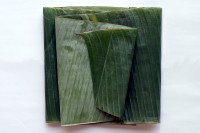 The leaves of the Banana tree are used in Thai cuisine to wrap foods before steaming. The leaf gives the food a slight flavor. They are never eaten, just used as a flavoring. They are also commonly used as tablecloths at markets! If you live somewhere where there are no Banana trees to steal leaves from, you can usually buy them frozen in bags at Asian groceries.
The leaves of the Banana tree are used in Thai cuisine to wrap foods before steaming. The leaf gives the food a slight flavor. They are never eaten, just used as a flavoring. They are also commonly used as tablecloths at markets! If you live somewhere where there are no Banana trees to steal leaves from, you can usually buy them frozen in bags at Asian groceries.Storage: Banana leaves can be kept in the refrigerator for a few weeks. For long term storage, you can freeze them sealed.
- Black Pepper Powder
Thai: ???????????? (prik thai dum bpon)
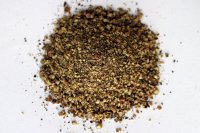 The same black pepper you see in Western cooking.
The same black pepper you see in Western cooking.Storage: Pepper can be stored in the cupboard for a really long time.
- Black Peppercorns
Thai: ?????????????? (ma-let prik thai dum)
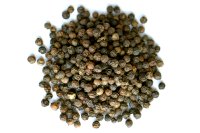 The same black pepper you see in Western cooking.
The same black pepper you see in Western cooking.Storage: Pepper can be stored in the cupboard for a really long time.
- Cardamom
Thai: ????????? (look gra-wan)
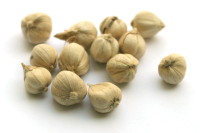 Cardamom seeds are used in Chinese, South East Asian and Indian cooking. They’re also used in some Western Desserts and Indian spiced tea (masala chai). A few roasted pods make a great addition to Massaman Curry. There are generally two types of cardamom, a green and very fragrant variety from India, and this brown fatter variety from China. Thais usually use the brown one.
Cardamom seeds are used in Chinese, South East Asian and Indian cooking. They’re also used in some Western Desserts and Indian spiced tea (masala chai). A few roasted pods make a great addition to Massaman Curry. There are generally two types of cardamom, a green and very fragrant variety from India, and this brown fatter variety from China. Thais usually use the brown one.Storage: The seeds will last months in the cupboard if kept airtight and dry.
- Cassia Leaves
Thai: ???????? (bai gra-wan)
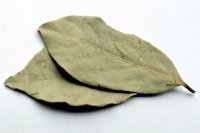 Cassia Leaves are very similar in appearance to Bay Leaves. These are dried leaves from the cassia tree, a type of cinnamon. They are primarily used in Massaman Curry. Commonly in Asian markets they are labeled “Indian Bay Leaves”.
Cassia Leaves are very similar in appearance to Bay Leaves. These are dried leaves from the cassia tree, a type of cinnamon. They are primarily used in Massaman Curry. Commonly in Asian markets they are labeled “Indian Bay Leaves”.Storage: The leaves will last months in the cupboard if kept airtight and dry.
- Chili Powder
Thai: ??????? (prik bpon)
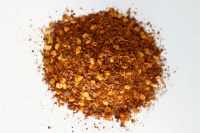 Chili Powder is made from dried and ground small chilies. It’s used to flavor and add spice mainly to soups and noodles.
Chili Powder is made from dried and ground small chilies. It’s used to flavor and add spice mainly to soups and noodles.Storage: Store chili powder sealed in the cupboard. It lasts for a really long time if kept dry.
- Cinnamon Sticks
Thai: ????? (ope cheuy)
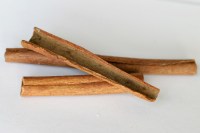 Cinnamon Sticks are used whole in some Chinese-Thai dishes, such as Five Spice Tofu. It is also sometimes put into Massaman Curry. However, Cinnamon is never used in sweets like it is in the West!
Cinnamon Sticks are used whole in some Chinese-Thai dishes, such as Five Spice Tofu. It is also sometimes put into Massaman Curry. However, Cinnamon is never used in sweets like it is in the West!Storage: Cinnamon will keep for a very long time if kept sealed in the cupboard, although the fresher it is, the more flavor it has.
- Coriander
Thai: ????? (pak chee)
 Americans call this herb by it’s Spanish name, Cilantro, while the English call it Coriander. It’s the same herb. Coriander has a very strong smell and taste, and I’ve found people either really love or hate it. The leaves are commonly used to garnish soups, and the roots are used in a lot of dishes. Thais use the seeds as well for some curry pastes.
Americans call this herb by it’s Spanish name, Cilantro, while the English call it Coriander. It’s the same herb. Coriander has a very strong smell and taste, and I’ve found people either really love or hate it. The leaves are commonly used to garnish soups, and the roots are used in a lot of dishes. Thais use the seeds as well for some curry pastes.Storage: Store coriander in a glass filled with water inside the fridge. If stored this way, it should last 2 weeks or so. If it comes with a rubber band or twist tie around it, remove that first for longer shelf life.
- Coriander Root
Thai: ???????? (raak pak chee)
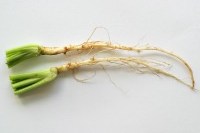 Thais use the root of the Coriander (Cilantro) plant as a flavoring in soups and curry pastes. It may be difficult to find Coriander in the West with the roots still on. I found that in Asian groceries, or sometimes in Latin groceries you can find it with the root. Cut the root with about 1/2″ of green (like shown) and wash very very well before adding to the dish. To get even more flavor in a soup, bruise the root with a stone mortar & pestle first.
Thais use the root of the Coriander (Cilantro) plant as a flavoring in soups and curry pastes. It may be difficult to find Coriander in the West with the roots still on. I found that in Asian groceries, or sometimes in Latin groceries you can find it with the root. Cut the root with about 1/2″ of green (like shown) and wash very very well before adding to the dish. To get even more flavor in a soup, bruise the root with a stone mortar & pestle first.Storage: Store coriander in a glass filled with water inside the fridge. If stored this way, it should last 2 weeks or so. If it comes with a rubber band or twist tie around it, remove that first for longer shelf life. You can also freeze the roots for long term storage.
- Coriander Seeds
Thai: ?????????? (ma-let pak chee)
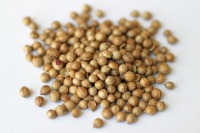 These are the seeds from the plant. They are bought already dried and I believe are unavailable fresh. They are commonly ground up in curry pastes.
These are the seeds from the plant. They are bought already dried and I believe are unavailable fresh. They are commonly ground up in curry pastes.Storage: Coriander seeds will last a long time when kept in the cupboard.
- Curry Powder
Thai: ???????? (pong ga-ree)
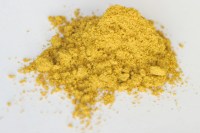 Curry Powder is a ground up blend of spices. It’s orange from tumeric. It’s more popular in Southern Thai cooking.
Curry Powder is a ground up blend of spices. It’s orange from tumeric. It’s more popular in Southern Thai cooking.Storage: Store sealed in the cupboard. It’ll keep for a long time.
- Finger Root
Thai: ?????? (gra-chaai)
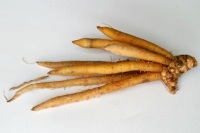 Finger Root is in the same family as galangal, but the taste is totally different. It is used in a few dishes, such as Kanom Jeen Numyaa and Gaeng Liang. It may be available frozen or in a jar in the West.
Finger Root is in the same family as galangal, but the taste is totally different. It is used in a few dishes, such as Kanom Jeen Numyaa and Gaeng Liang. It may be available frozen or in a jar in the West.Storage: Store in the refrigerator, or sealed in the freezer for long term storage.
- Fresh Peppercorns
Thai: ??????????? (prik thai onn)
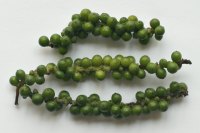 Whole fresh peppercorns still on the stem are thrown into some dishes, notably ‘Phad Kee Mao’ and ‘Gaeng Paa’.
Whole fresh peppercorns still on the stem are thrown into some dishes, notably ‘Phad Kee Mao’ and ‘Gaeng Paa’.Storage: Store fresh peppercorns sealed in the refrigerator. They should last a few weeks or so.
- Galangal
Thai: ??? (khaa)
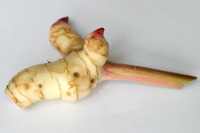 Galangal is the khaa in Tom Khaa. Also used in Tom Yum and curry pastes. You can not substitute ginger for galangal, or any other root. You can usually find it frozen in South East Asian groceries. Sometimes Chinese groceries carry it too — you may have to ask. Galangal is recognizable by the long pink stalks and pink tips on the root.
Galangal is the khaa in Tom Khaa. Also used in Tom Yum and curry pastes. You can not substitute ginger for galangal, or any other root. You can usually find it frozen in South East Asian groceries. Sometimes Chinese groceries carry it too — you may have to ask. Galangal is recognizable by the long pink stalks and pink tips on the root.Storage: Keep in the refrigerator, or store sealed in the freezer.
- Garlic
Thai: ???????? (gra-tiem)
 Garlic is used in virtually all Thai dishes. The garlic which is found in Thailand has a stronger flavor than the western version, but all garlic can be used in Thai cooking. The garlic found in Thailand has much smaller cloves, so instead of calling for cloves in recipes, I call by teaspoon or tablespoon.
Garlic is used in virtually all Thai dishes. The garlic which is found in Thailand has a stronger flavor than the western version, but all garlic can be used in Thai cooking. The garlic found in Thailand has much smaller cloves, so instead of calling for cloves in recipes, I call by teaspoon or tablespoon.Preparation: To prepare garlic, first smash the clove with the side of the knife to break the clove somewhat. This will both release the juice and loosen the paper/skin. Then peel the skin off, and chop on a cutting board. There are 3 different sizes you can chop, depending on the recipe used. The smallest size is ‘diced’, followed by ‘chopped’, then ‘full clove’.
Storage: Garlic can be stored unrefrigerated for weeks at a time. When the the clove is brown and soft, it’s time to throw it away.
- Garlic Chives
Thai: ??????? (guay chai)
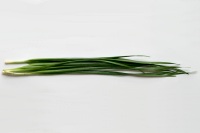 Garlic Chives are different than the purple flower ones you find in the West (my Grandfather used to grow them!). The leaves are flat, and not hollow and round, and the flavor is different. Garlic Chives are used in Chinese-Thai stir fries, and Thailand’s most famous dish: Pad Thai.
Garlic Chives are different than the purple flower ones you find in the West (my Grandfather used to grow them!). The leaves are flat, and not hollow and round, and the flavor is different. Garlic Chives are used in Chinese-Thai stir fries, and Thailand’s most famous dish: Pad Thai.Storage: Store Garlic Chives sealed in the refrigerator with some air in the bag.
- Ginger
Thai: ??? (khing)
 Ginger is used for some Chinese-Thai dishes. Peel or cut off the skin before using. Ginger is also excellent for stomach issues. If your stomach is a bit off, make yourself some ginger tea by boiling a few slices of ginger and adding a couple spoons of sugar. It’ll fix nausea too! Works better than any medicine you can buy.
Ginger is used for some Chinese-Thai dishes. Peel or cut off the skin before using. Ginger is also excellent for stomach issues. If your stomach is a bit off, make yourself some ginger tea by boiling a few slices of ginger and adding a couple spoons of sugar. It’ll fix nausea too! Works better than any medicine you can buy.Storage: Store in the refrigerator. Ginger keeps well for a very long time.
- Holy Basil
Thai: ???????? (bai ga-prao)
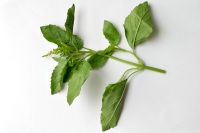 This is the type of basil which is stir fried with meat or tofu to make Pad Ga-prao, sometimes written in English as ‘stir fried with basil’. This basil is extremely difficult to find fresh outside of Thailand as it spoils fast. If you are lucky enough to find it, use it the same day you purchase it. This basil has big wide green leaves, green stems and green flowers.
This is the type of basil which is stir fried with meat or tofu to make Pad Ga-prao, sometimes written in English as ‘stir fried with basil’. This basil is extremely difficult to find fresh outside of Thailand as it spoils fast. If you are lucky enough to find it, use it the same day you purchase it. This basil has big wide green leaves, green stems and green flowers.Storage: This basil goes bad very fast. Keep in a plastic bag with some air inside on the bottom shelf or drawer in your refrigerator. When the leaves are black, it’s bad.
- Large Dried Chilies
Thai: ?????????????? (prik chee faa haang)
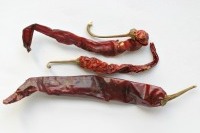 These chilies are the key ingredient in ‘Red Curry Paste’. It’s what gives that curry it’s flavor and distinctive red color. They are not very spicy at all. If you want a hotter Red Curry, you’ll need to add some small dried chilies too. These chilies are about 5-8″ long.
These chilies are the key ingredient in ‘Red Curry Paste’. It’s what gives that curry it’s flavor and distinctive red color. They are not very spicy at all. If you want a hotter Red Curry, you’ll need to add some small dried chilies too. These chilies are about 5-8″ long.Storage: Store dried chilies sealed in the cupboard. They last for a really long time if kept dry.
- Lemon Basil
Thai: ???????? (bai maeng-luck)
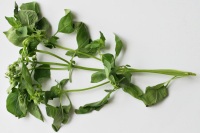 Lemon basil is used most often with seafood and in soup. Lemon basil has a real citrus-like smell and taste. This basil has small green leaves, green stem and white flowers.
Lemon basil is used most often with seafood and in soup. Lemon basil has a real citrus-like smell and taste. This basil has small green leaves, green stem and white flowers.Storage: Lemon basil goes bad fast. Keep in a plastic bag with some air inside on the bottom shelf or drawer in your refrigerator. When the leaves are black, it’s bad.
- Lemongrass
Thai: ?????? (dta-khrai)
 Lemongrass is a grass which has a citrus smell to it. It is used in soups such as Tom Yum, Thai curries and is sliced for use in salads (yum). The bottom part of the stalk is used, the first 1/3 to 1/2.
Lemongrass is a grass which has a citrus smell to it. It is used in soups such as Tom Yum, Thai curries and is sliced for use in salads (yum). The bottom part of the stalk is used, the first 1/3 to 1/2.Storage: Keep in the refrigerator, or store sealed in the freezer.
- Light Green Chilies
Thai: ???????? (prik youak)
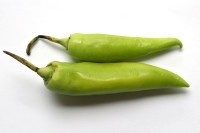 Light green chilies are spicy, but not as spicy as prik kee nuu. These chilies are often stir fried with pork.
Light green chilies are spicy, but not as spicy as prik kee nuu. These chilies are often stir fried with pork.Storage: You can store chilies sealed in the refrigerator, or frozen in the freezer. I tend to buy a bunch and freeze them, as I don’t notice much difference in flavor, and they last forever.
- Lime Leaves
Thai: ???????? (bai ma-groot)
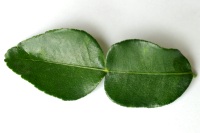 Lime leaves have a citrus like taste, and are used to flavor soups and curries. Lime leaves are sometimes called ‘Kaffir Lime Leaves’, but I read recently that ‘Kaffir’ is an ethnic slur in some parts of the world, so I will just call them Lime Leaves!
Lime leaves have a citrus like taste, and are used to flavor soups and curries. Lime leaves are sometimes called ‘Kaffir Lime Leaves’, but I read recently that ‘Kaffir’ is an ethnic slur in some parts of the world, so I will just call them Lime Leaves!Storage: Keep in a bag in the refrigerator, or store sealed in the freezer for long-term storage.
- Long Coriander
Thai: ?????????? (pak chee farang)
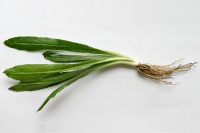 Long Coriander is sometimes called ‘Saw Tooth Coriander’ or ‘Culantro’ (not Cilantro). It’s native to Central America and the Caribbean, hence why Thais call it ‘foreigner coriander’. It’s mainly used to flavor soups. If you cannot find Long Coriander, regular coriander/cilantro leaves can be used, but the flavor is different.
Long Coriander is sometimes called ‘Saw Tooth Coriander’ or ‘Culantro’ (not Cilantro). It’s native to Central America and the Caribbean, hence why Thais call it ‘foreigner coriander’. It’s mainly used to flavor soups. If you cannot find Long Coriander, regular coriander/cilantro leaves can be used, but the flavor is different.Storage: Store long coriander in a glass filled with water inside the fridge. If stored this way, it should last 2 weeks or so. If it comes with a rubber band or twist tie around it, remove that first for longer shelf life.
- Long Thai Chilies
Thai: ?????????? (prik chee faa)
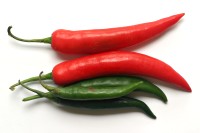 Long chilies aren’t very spicy, but have a nice flavor. They are most commonly used dried to make red curry paste. The name of this chili translates into English as “Chili which points to the sky”, or “sky pointing chili”. These chilies are about 4-8″ in length, about 3-4x as long as the medium-sized chili above.
Long chilies aren’t very spicy, but have a nice flavor. They are most commonly used dried to make red curry paste. The name of this chili translates into English as “Chili which points to the sky”, or “sky pointing chili”. These chilies are about 4-8″ in length, about 3-4x as long as the medium-sized chili above.Storage: You can store chilies sealed in the refrigerator, or frozen in the freezer. I tend to buy a bunch and freeze them, as I don’t notice much difference in flavor, and they last forever.
- Medium-Sized Thai Chilies
Thai: ?????????? (prik kee noo)
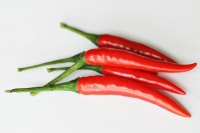 Medium-sized chilies are not as hot as small chilies, although they have the same name as the small ones. The flavor is a bit different too. The name translates to mouse shit chili.
Medium-sized chilies are not as hot as small chilies, although they have the same name as the small ones. The flavor is a bit different too. The name translates to mouse shit chili.Storage: You can store chilies sealed in the refrigerator, or frozen in the freezer. If you are somewhere where you can’t buy them easily, you can buy a bunch and store them in the freezer. There’s not too much of a loss of flavor, and they last forever.
- Mint
Thai: ???????? (sa-ra-nae)
 Mint is used in North-East (Issan) dishes such as Laap and Naam Tok and other salads.
Mint is used in North-East (Issan) dishes such as Laap and Naam Tok and other salads.Storage: Store Mint in a bag in the refrigerator on the bottom shelf or inside the drawers. It goes bad pretty fast, so make sure to use it right away.
- Onion
Thai: ?????? (hua hawm)
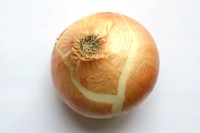 Onions are not used as often as shallots, but they are pretty common. They are used primarily in yum (Thai salads) and some curries. They are also stir fried into some dishes.
Onions are not used as often as shallots, but they are pretty common. They are used primarily in yum (Thai salads) and some curries. They are also stir fried into some dishes.Storage: Onions can be stored unrefrigerated for many weeks at a time. If the bulb is soft, it’s time to buy new onions.
- Orange Chilies
Thai: ?????????? (prik leung)
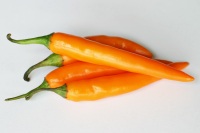 Orange chilies are spicy, but not as spicy as prik kee nuu. They have a lot of flavor too. Orange chilies are used most often in “Pad Phet”. Buying these outside Thailand may be difficult. You can substitute with prik kee nuu, but the taste will be different.
Orange chilies are spicy, but not as spicy as prik kee nuu. They have a lot of flavor too. Orange chilies are used most often in “Pad Phet”. Buying these outside Thailand may be difficult. You can substitute with prik kee nuu, but the taste will be different.Storage: You can store chilies sealed in the refrigerator, or frozen in the freezer. I tend to buy a bunch and freeze them, as I don’t notice much difference in flavor, and they last forever.
- Palm Sugar
Thai: ????????? (naam dtaan bpuk)
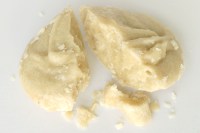 Palm Sugar is sugar made from boiling the sap from the cut fruit stalks of the palm tree. There are two types of palm trees used in making palm sugar. Either type can be used for recipes. The flavor is somewhat similar to ‘Maple Sugar Candy’. Thai curries and sweets are sweetened with this type of sugar.
Palm Sugar is sugar made from boiling the sap from the cut fruit stalks of the palm tree. There are two types of palm trees used in making palm sugar. Either type can be used for recipes. The flavor is somewhat similar to ‘Maple Sugar Candy’. Thai curries and sweets are sweetened with this type of sugar.Storage: Store sealed in the cupboard or refrigerator. Palm Sugar will keep for a long time.
- Pandan Leaves
Thai: ????? (bai dtoey)
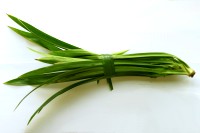 Pandan leaves are used for wrapping up food prior to steaming or frying, as well as giving many Thai desserts their flavor. When you see green colored desserts, likely the flavor is pandan. It’s also common to boil the leaves and use the tea as an additive to plain water. In the West, you can usually find these leaves frozen, or sometimes you can buy ‘pandan essence’ liquid in small bottles.
Pandan leaves are used for wrapping up food prior to steaming or frying, as well as giving many Thai desserts their flavor. When you see green colored desserts, likely the flavor is pandan. It’s also common to boil the leaves and use the tea as an additive to plain water. In the West, you can usually find these leaves frozen, or sometimes you can buy ‘pandan essence’ liquid in small bottles.Storage: Pandan will last a few weeks if kept sealed in the refrigerator. Freezing it will make it lose a substantial amount of flavor.
- Peanuts
Thai: ???????? (tua li-song)
 Peanuts are used in a few dishes. The most popular of which are Som Tum and Massaman Curry. It’s easiest to purchase pre-roasted peanuts, but make sure they are “dry-roasted” and unsalted.
Peanuts are used in a few dishes. The most popular of which are Som Tum and Massaman Curry. It’s easiest to purchase pre-roasted peanuts, but make sure they are “dry-roasted” and unsalted.Storage: Peanuts (and natural peanut butter) get a funny smell when they’re old, usually after about a month or so. If they smell funny, ditch them and get fresh ones.
- Salt
Thai: ????? (gleua)
 While Fish Sauce is the traditional ‘salty’ element in Thai cooking, salt is sometimes used. Salt is most commonly used to preserve things such as eggs and fish. Personally, I use it for a vegetarian substitute in dishes where white soy sauce doesn’t go with the flavor. I prefer the taste of sea salt. Course sea salt is also used in some curry pastes to both help grind the paste and to preserve it.
While Fish Sauce is the traditional ‘salty’ element in Thai cooking, salt is sometimes used. Salt is most commonly used to preserve things such as eggs and fish. Personally, I use it for a vegetarian substitute in dishes where white soy sauce doesn’t go with the flavor. I prefer the taste of sea salt. Course sea salt is also used in some curry pastes to both help grind the paste and to preserve it.Storage: Salt can be stored in the cupboard for a really long time. Try to keep it as dry as possible.
- Scallions
Thai: ?????? (dton hawm)
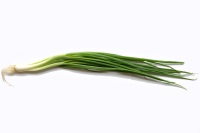 Scallions (Spring Onions) are used for many different dishes in Thailand. They commonly garnish soups, are used in salads (yum), and sometimes even put into dessert (Khanom Krok).
Scallions (Spring Onions) are used for many different dishes in Thailand. They commonly garnish soups, are used in salads (yum), and sometimes even put into dessert (Khanom Krok).Preparation: Wash the scallions and cut off the roots. Cut the white bottom of the scallions thin, and as you get closer to the green, cut wider pieces.
Storage: Store scallions in a plastic bag with air inside on the bottom shelf of the refrigerator. They should last at least a week if they’re not wet.
- Shallots
Thai: ?????? (hawm daeng)
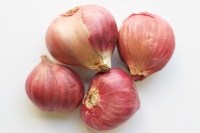 Shallots are used in Thai cooking almost as much as garlic. The shallots which are found in Thailand are smaller than the European varieties, and are a touch more flavorful.
Shallots are used in Thai cooking almost as much as garlic. The shallots which are found in Thailand are smaller than the European varieties, and are a touch more flavorful.Preparation: To prepare shallots, first cut off the bottom (roots) and then peel off the paper skin. As with any onion, it’s best to not stand directly over the onion, so that you don’t get the onion fumes and start to cry. Keep cutting the shallot lengthwise starting from the first cut you made before. Shallots taste really yummy when cut thin.
Storage: Shallots can be stored unrefrigerated for many weeks at a time. If the bulb is soft, it’s time to buy new shallots!
- Small Dried Chilies
Thai: ?????????????? (prik kee noo haang)
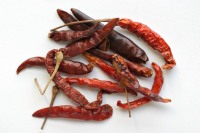 Small Dried Chilies are hotter than the larger ones, but not as hot as fresh chilies. Some dishes call for dried chilies to be used instead of fresh. They are also thrown into curry pastes to give some kick. These chilies are about 2-3″ long.
Small Dried Chilies are hotter than the larger ones, but not as hot as fresh chilies. Some dishes call for dried chilies to be used instead of fresh. They are also thrown into curry pastes to give some kick. These chilies are about 2-3″ long.Storage: Store dried chilies sealed in the cupboard. They last for a really long time if kept dry.
- Small Thai Chilies
Thai: ????????????? (prik kee noo suan)
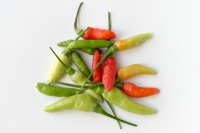 Small chilies are hotter than the Medium chilies. The name of this chili in Thai means ‘garden mouse sh*t chili’. Not joke. Literal translation.
Small chilies are hotter than the Medium chilies. The name of this chili in Thai means ‘garden mouse sh*t chili’. Not joke. Literal translation.Storage: You can store chilies sealed in the refrigerator, or frozen in the freezer. If you are somewhere where you can’t buy them easily, you can buy a bunch and store them in the freezer. There’s not too much of a loss of flavor, and they last forever.
- Star Anise
Thai: ???????? (boi gak)
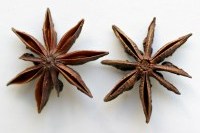 Star Anise is used in some Chinese-Thai dishes, such as Five Spice Tofu.
Star Anise is used in some Chinese-Thai dishes, such as Five Spice Tofu.Storage: Star anise will keep a long time if kept sealed in the cupboard.
- Thai Basil
Thai: ???????? (bai horapa)
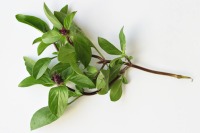 Thai basil is the easiest basil to get outside Thailand. This basil has medium sized green leaves, purple stem and purple flowers. It’s quite fragrant, and the smell is quite unlike the other two basils which are popular in Thailand. This basil is eaten with some curries and noodle soups.
Thai basil is the easiest basil to get outside Thailand. This basil has medium sized green leaves, purple stem and purple flowers. It’s quite fragrant, and the smell is quite unlike the other two basils which are popular in Thailand. This basil is eaten with some curries and noodle soups.Storage: Thai basil goes bad fast. Keep in a plastic bag with some air inside on the bottom shelf or drawer in your refrigerator. When the leaves are black, it’s bad.
- Turmeric
Thai: ????? (khamin)
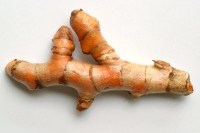 Turmeric is a bright orange colored root. It adds color and flavor to certain dishes, and is mainly used in Southern Thai food. This stuff stains, and will take days or even weeks to wash off even your hands! Be careful!
Turmeric is a bright orange colored root. It adds color and flavor to certain dishes, and is mainly used in Southern Thai food. This stuff stains, and will take days or even weeks to wash off even your hands! Be careful!Storage: Store in the refrigerator, or sealed in the freezer for long term storage.
- White Pepper Powder
Thai: ?????????? (prik thai bpon)
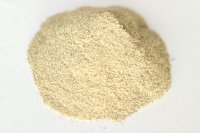 White pepper has a different flavor than black pepper, and really should not be substituted. The most popular brand is Nguan Soon.
White pepper has a different flavor than black pepper, and really should not be substituted. The most popular brand is Nguan Soon.Storage: Pepper can be stored in the cupboard for a really long time.
- White Peppercorns
Thai: ???????????? (ma-let prik thai)
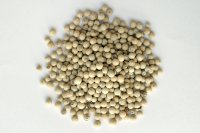 White pepper has a different flavor than black pepper, and really should not be substituted. The most popular brand is Nguan Soon.
White pepper has a different flavor than black pepper, and really should not be substituted. The most popular brand is Nguan Soon.Storage: Pepper can be stored in the cupboard for a really long time.
- White Sugar
Thai: ????????????? (naam dtaan saay khaaw)
 White sugar is used in a lot of dishes. Use regular white cane sugar, or feel free to use the natural unbleached cane sugar (but not the ‘brown sugar’ which is used in baking).
White sugar is used in a lot of dishes. Use regular white cane sugar, or feel free to use the natural unbleached cane sugar (but not the ‘brown sugar’ which is used in baking).Storage: Store in a cupboard, away from moisture. I always put my sugars in a sealed plastic box, so they don’t get too dry or wet, depending on the season.
- Young Ginger
Thai: ??????? (khing onn)
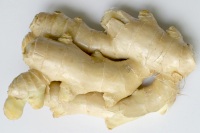 Young ginger is picked earlier than regular ginger and has a more subtle flavor. The skin is very light colored and thin, and can be left on for cooking. Be careful not to confuse this with galangal, as they look somewhat similar. The flavor is not the same! If you’re unsure, ask the vendor.
Young ginger is picked earlier than regular ginger and has a more subtle flavor. The skin is very light colored and thin, and can be left on for cooking. Be careful not to confuse this with galangal, as they look somewhat similar. The flavor is not the same! If you’re unsure, ask the vendor.Storage: Store in the refrigerator. Ginger keeps well for a long time.